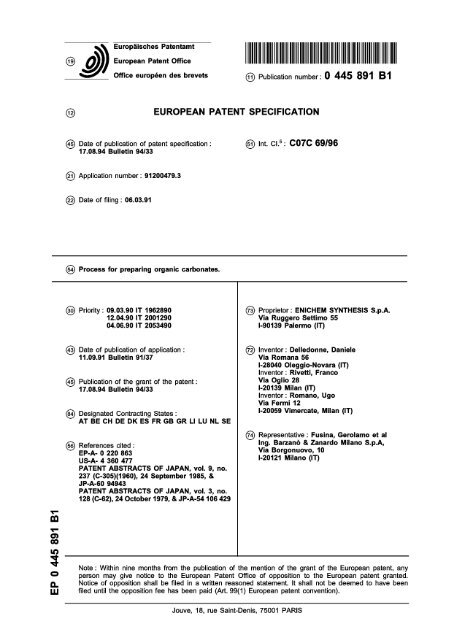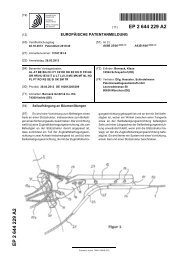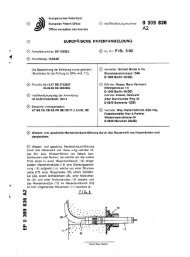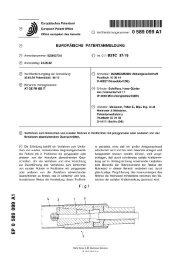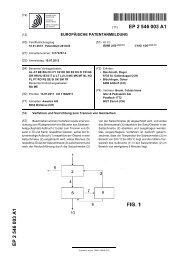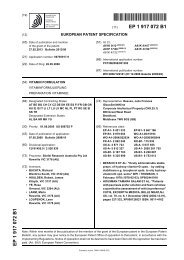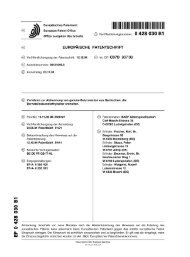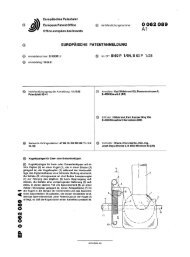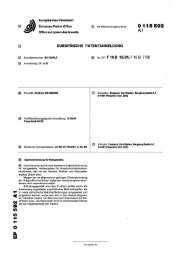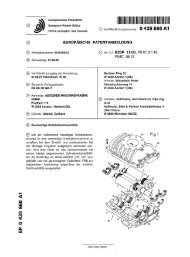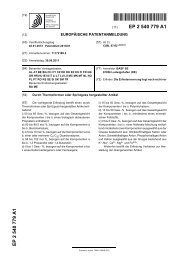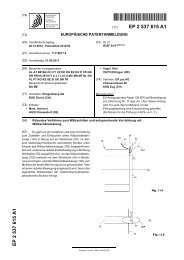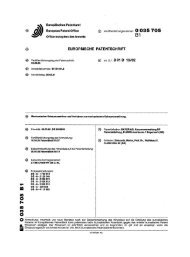European Patent Office - EP 0445891 B1
European Patent Office - EP 0445891 B1
European Patent Office - EP 0445891 B1
You also want an ePaper? Increase the reach of your titles
YUMPU automatically turns print PDFs into web optimized ePapers that Google loves.
<strong>Patent</strong>amtJEuropaisches <strong>European</strong> <strong>Patent</strong> <strong>Office</strong><strong>Office</strong> europeen des brevets © Publication number: 0 445 891 <strong>B1</strong>@ EUROPEAN PATENT SPECIFICATION@ Date of publication of patent specification : @ Int. CI.5 : C07C 69/9617.08.94 Bulletin 94/33(21) Application number : 91200479.3(22) Date of filing : 06.03.91(S) Process for preparing organic carbonates.(30) Priority : 09.03.90 IT 196289012.04.90 IT 200129004.06.90 IT 2053490@ Proprietor : ENICHEM SYNTHESIS S.p.A.Via Ruggero Settimo 551-90139 Palermo (IT)(43) Date of publication of application :11.09.91 Bulletin 91/37(45) Publication of the grant of the patent :17.08.94 Bulletin 94/33@ Designated Contracting States :AT BE CH DE DK ES FR GB GR LI LU NL SE(56) References cited :<strong>EP</strong>-A- 0 220 863US-A- 4 360 477PATENT ABSTRACTS OF JAPAN, vol. 9, no.237 (C-305)(1960), 24 September 1985, &JP-A-60 94943PATENT ABSTRACTS OF JAPAN, vol. 3, no.128 (C-62), 24 October 1979, & JP-A-54 106 429(72) Inventor : Delledonne, DanieleVia Romana 56I-28040 Oleggio-Novara (IT)Inventor : Rivetti, FrancoVia Oglio 281-20139 Milan (IT)Inventor : Romano, UgoVia Fermi 12I-20059 Vimercate, Milan (IT)(74) Representative : Fusina, Gerolamo et alIng. Barzano & Zanardo Milano S.p.A,Via Borgonuovo, 101-20121 Milano (IT)00If)LUNote : Within nine months from the publication of the mention of the grant of the <strong>European</strong> patent, anyperson may give notice to the <strong>European</strong> <strong>Patent</strong> <strong>Office</strong> of opposition to the <strong>European</strong> patent granted.Notice of opposition shall be filed in a written reasoned statement. It shall not be deemed to have beenfiled until the opposition fee has been paid (Art. 99(1) <strong>European</strong> patent convention).Jouve, 18, rue Saint-Denis, 75001 PARIS
<strong>EP</strong> 0 445 891 <strong>B1</strong>Addition 1st 2nd 3rdTime (min) 130 170 165DMC (mmoles) 56 56 45(grams) 5.04 5.4 4.05DMC total(mmoles) 111 167 212(grams) 9.99 15.03 19.02DMC = dimethylcarbonateEXAMPLE 2555 g of methanol, 0.9 g (8.7 mmoles) of butyl nitrite and 4.95 g (29 mmoles) of hydrobromic acid in 48 wt%aqueous solution are introduced into a 250 ml pressure vessel lined internally with Teflon and fitted with amechanical stirrer and heat transfer means. Carbon monoxide and oxygen are fed into the pressure vessel topartial pressures of 2 MPa and 0.7 MPa (20 and 7 kg/cm2) respectively. It is heated to 90°C under stirring for120 minutes. It is then cooled to ambient temperature, the gas vented and the liquid subjected to gaschromatographyanalysis.A dimethyl carbonate yield of 8.91 g (99 mmoles) is determined.EXAMPLE 2655 g of methanol, 0.43 g (1.1 mmoles) of gallium trinitrate and 4.95 g (29 mmoles) of hydrobromic acid in48 wt% aqueous solution are introduced into a 250 ml pressure vessel lined internally with Teflon and fittedwith a mechanical stirrer and heat transfer means. Carbon monoxide and oxygen are fed into the pressurevessel to partial pressures of 2 MPa and 0.7 MPa (20 and 7 kg/cm2) respectively. It is heated to 80°C understirring for 140 minutes. It is then cooled to ambient temperature, the gas vented and the liquid subjected togaschromatography analysis.A dimethyl carbonate yield of 5.49 g (61 mmoles) is determined.EXAMPLE 2755.2 g of methanol, 0.15 g (2.1 mmoles) of sodium nitrite, 2.08 g (24 mmoles) of lithium bromide and 1.32g (7.8 mmoles) of hydrobromic acid in 48 wt% aqueous solution are introduced into a 250 ml pressure vessellined internally with Teflon and fitted with a mechanical stirrer and heat transfer means. Carbon monoxideand oxygen are fed into the pressure vessel to partial pressures of 2 MPa and 0.7 MPa (20 and 7 kg/cm2) respectively.It is heated to 80°C under stirring for 140 minutes. It is then cooled to ambient temperature, thegas vented and the liquid subjected to gaschromatography analysis.A dimethyl carbonate yield of 5.58 g (62 mmoles) is determined.EXAMPLE 2861 .29 g of methanol, 5.68 g (75 mmoles) of N203 and 4.95 g (29 mmoles) of hydrobromic acid in 48 wt%aqueous solution are introduced into a 250 ml pressure vessel lined internally with Teflon and fitted with amechanical stirrer and heat transfer means. Carbon monoxide and oxygen are fed into the pressure vessel topartial pressures of 2 MPa and 0.7 MPa (20 and 7 kg/cm2) respectively. It is heated to 85°C under stirring for240 minutes. It is then cooled to ambient temperature, the gas vented and the liquid subjected to gaschromatographyanalysis.10
<strong>EP</strong> 0 445 891 <strong>B1</strong>A dimethyl carbonate yield of 45.25 g (503 mmoles) is determined.EXAMPLE 295 48.5 g of methanol, 1.43 g (19 mmoles) of N203 and 1.68 g (10 mmoles) of hydrobromic acid in 48 wt%aqueous solution are introduced into a 250 ml pressure vessel lined internally with Teflon and fitted with amechanical stirrer and heat transfer means. Carbon monoxide and oxygen are fed into the pressure vessel topartial pressures of 2 MPa and 0.7 MPa (20 and 7 kg/cm2) respectively. It is heated to 80°C under stirring for75 minutes. It is then cooled to ambient temperature, the gas vented and the liquid subjected to gaschroma-10 tography analysis.A dimethyl carbonate yield of 6.03 g (67 mmoles) is determined.EXAMPLE 3015 50 g of methanol, 1 .37 g (1 8 mmoles) of N203, 1 .68 g (1 0 mmoles) of hydrobromic acid in 48 wt% aqueoussolution and 26.2 mg (0.1 mmoles) of lithium tetrachloropalladate (Li2PdCI4) are introduced into a 250 ml pressurevessel lined internally with Tef lon and fitted with a mechanical stirrer and heat transfer means. Carbonmonoxide and oxygen are fed into the pressure vessel to partial pressures of 2 MPa and 0.5 MPa (20 and 7kg/cm2) respectively. It is heated to 80°C under stirring for 20 minutes. It is then cooled to ambient temperature,20 the gas vented and the liquid subjected to gaschromatography analysis.A dimethyl carbonate yield of 5.13 g (57 mmoles) is determined.EXAMPLE 3125 40 g of methanol, 2.07 g (33 mmoles) of fuming nitric acid and 0.54 g (3.3 mmoles) of bromine are introducedinto a 250 ml pressure vessel lined internally with Tef lon and fitted with a mechanical stirrer and heattransfer means. Carbon monoxide is fed into the pressure vessel to a pressure of 2.5 MPa (25 kg/cm2). It isheated to 100°C under stirring for 120 minutes. It is then cooled to ambient temperature, the gas vented andthe liquid subjected to gaschromatography analysis.30 A dimethyl carbonate yield of 2.88 g (32 mmoles) is determined.EXAMPLE 3260 g of methanol, 5.25 g (50 mmoles) of lithium nitrate dihydrate and 0.809 g (5.5 mmoles) of bromine are35 introduced into a 250 ml pressure vessel lined internally with Tef lon and fitted with a mechanical stirrer andheat transfer means. Carbon monoxide is fed into the pressure vessel to a pressure of 1 MPa (10 kg/cm2).It is heated to 1 00°C under stirring for 1 80 minutes. It is then cooled to ambient temperature, the gas ventedand the liquid subjected to gaschromatography analysis.A dimethyl carbonate yield of 1.29 g (14.3 mmoles) is determined.40EXAMPLE 3360 g of methanol, 9.71 g (100 moles) of hydrogen peroxide in a 35 wt% aqueous solution and 1.61 g(9.58mmoles) of hydrobromic acid in 48 wt% aqueous solution are introduced into a 250 ml pressure vessel45 lined internally with Teflon and fitted with a mechanical stirrer and heat transfer means. Carbon monoxideis fed into the pressure vessel to a pressure of 3 MPa (30 kg/cm2). It is heated to 80°C under stirring for 75minutes. It is then cooled to ambient temperature, the gas vented and the liquid subjected to gaschromatographyanalysis.A dimethyl carbonate yield of 3.15 g (35 mmoles) is determined.50EXAMPLE 3460 g of methanol, 9.00 g (80 mmoles) of tert-butyl hydroperoxide in an 80 wt% solution in di-tert-butyl peroxideand 1 .76 g (1 0.5 mmoles) of hydrobromic acid in 48 wt% aqueous solution are introduced into a 250 ml55 pressure vessel lined internally with Tef lon and fitted with a mechanical stirrerand heat transfer means. Carbonmonoxide is fed into the pressure vessel to a pressure of 3 MPa (30 kg/cm2). It is heated to 65°C understirring for 120 minutes. It is then cooled to ambient temperature, the gas vented and the liquid subjected togaschromatography analysis.11
<strong>EP</strong> 0 445 891 <strong>B1</strong>A dimethyl carbonate yield of 2.88 g (32 mmoles) is determined.EXAMPLE 355 60 g of methanol, 12.2 g (51 moles) of sodium peroxydisulphate and 1 .68 g (1 0 mmoles) of hydrobromicacid in 48 wt% aqueous solution are introduced into a 250 ml pressure vessel lined internally with Teflonand fitted with a mechanical stirrer and heat transfer means. Carbon monoxide is fed into the pressure vesselto a pressure of 3 MPa (30 kg/cm2). It is heated to 110°C under stirring for 105 minutes. It is then cooled toambient temperature, the gas vented and the liquid subjected to gaschromatography analysis.10 A dimethyl carbonate yield of 1 .35 g (1 5 mmoles) is determined.EXAMPLE 3670 g of methanol, 8.9 g (50 moles) of N-bromosuccinimide and 1.68 g (10 mmoles) of hydrobromic acid in15 48 wt% aqueous solution are introduced into a 250 ml pressure vessel lined internally with Teflon and fittedwith a mechanical stirrer and heat transfer means. Carbon monoxide is fed into the pressure vessel to a pressureof 3 MPa (30 kg/cm2). It is heated to 70°C under stirring for 120 minutes. It is then cooled to ambient temperature,the gas vented and the liquid subjected to gaschromatography analysis.A dimethyl carbonate yield of 4.23 g (47 mmoles) is determined.20Claims251. A process for preparing an organic carbonate having the general formula:OR35or a cyclic organic carbonate having the general formula:40(II)45wherein: R is a CrC10 linear or branched alkyl, or a C5-C6 cycloalkyl, and R' is a C2-C5 linear or branchedalkylene, by reacting an alcohol R-OH, or a diol HO-R'-OH, respectively, with carbon monoxide at a tem-50 perature of from 25°C to 200°C, the cabon monoxide pressure being of from 0,1 MPa to 1 0 MPa (1 kg/cm2to 100 kg/cm2), characterized in that said reaction is carried out in the presence of a catalyst consistingof a halogen selected from chlorine, bromine and iodine, or in the presence of a catalyst consisting of saidhalogen and/or a halide ion selected from the chloride, the bromide and the iodide ion and an oxidizingagent capable of oxidizing said halide ion to its corresponding halogen, with the proviso that said halide55 ion is other than an ion derived from the halides of a metal of the platinum group or of copper.2. A process as claimed in claim 1 , characterised in that R-OH is chosen from methanol, ethanol, n-propanol,iso-propanol, n-butanol, iso-butanol, 2-ethylhexanol and cyclohexanol, and is preferably methanol; and12
<strong>EP</strong> 0 445 891 <strong>B1</strong>HO-R'-OH is chosen from ethylene glycol and propylene glycol.5103. A process as claimed in claim 1 , characterised in that the halogen is chosen from bromine and iodine andis preferably bromine.4. A process as claimed in claim 1, characterised in that the halide is chosen from bromide and iodide andis preferably bromide.5. A process as claimed in claim 1, characterised in that the oxidizing agent is chosen from:a) hydrogen peroxide, an organic percompound, N-bromosuccinimide, a nitrogen oxide, nitrous acid,nitric acid, a sulphur peracid, or a metal salt or an ester of said acids and peracids; orb) an oxidizing system formed from oxygen and an oxygenated nitrogen compound chosen from nitrogenoxides, nitrous and nitric acids, and the salts or esters of said acids.6. A process as claimed in claim 5, characterised in that the oxidizing agent (a) is chosen from hydrogen15 peroxide with a concentration of the order of 35-60% by weight; organic peroxides, hydroperoxides andperesters, and preferably tert-butyl hydroperoxide and di-tert-butyl peroxide; N02, (N204), N203 and N205;nitric acid having a concentration of about 67% by weight or more; suitable nitrate and nitrite salts of alkalineor alkaline earth metals or ammonium; alkyl esters of nitrous and nitric acids; and peroxydisulphuricacid salts of alkaline or alkaline earth metals.207. A process as claimed in claim 5, characterised in that in the oxidizing system (b) the oxygenated nitrogencompound is chosen from NO, N02, (N204), N203 and N205; nitric acid having a concentration of about67% by weight; nitrate and nitrite salts of alkaline or alkaline earth metals, ammonium, cerium and gallium.25 8. A process as claimed in claim 1, characterised by using a halogen in the absence of an oxidizing agent,and operating at a temperature of between 25 and 200°C, and preferably between 50 and 150°C, undera carbon monoxide pressure of between 0.1 MPa and 10 MPa (1 and 100 kg/cm2) for a reaction time ofbetween 1 and 240 minutes, and preferably of the order of 5-120 minutes.30 9. A process as claimed in claim 8, characterised by operating in the presence of a base able to block thehydrohalogen acid which forms as reaction co-product3510. Aprocess as claimed in claim 1, characterised by using a halogen and/ora halide ion, in the presence ofthe oxidizing agent (a), operating at a halogen or halide ion concentration of between lO^and 1 mole/litreand an oxidizing agent (a) concentration of between 10~1 and 5 moles/litre of alcohol, with a mole ratiogenerally of between 1:100 and 1:1, at a temperature of between 25 and 200°C under a carbon monoxidepressure of between 0.1 MPa and 10 Mpa (1 and 100 kg/cm2) for a reaction time of between about 1 andabout 240 minutes.11. A process as claimed in claim 1 0, characterised in that the halogen or halide ion concentration varies from10"2 to 0.5 moles/litre, the oxidizing agent concentration varies from 10~1 to 2 moles/litre of alcohol, themolar ratio of halogen or halide ion to oxidizing agent varies from 1:50 to 1:1, the temperature varies from50 to 120°C and the carbon monoxide pressure varies from 2 to 100 kg/cm2.12. A process as claimed in claim 1 , characterised by using a halogen and/or a halide ion, in the presence ofthe oxidizing system (b), operating at a halogen or halide ion concentration of between 10"3 and 2 moles/litreof alcohol and an oxygenated nitrogen compound concentration of between 10"3and 2 moles/litreof alcohol, their molar ratio being between 500:1 and 0.002:1, at a temperature of between 25 and 200°Cunder a total carbon monoxide plus oxygen pressure of between 0.1 MPa and 10 MPa (1 and 100 kg/cm2)and with ratio of oxygen partial pressure to carbon monoxide partial pressure of between 0.005:1 and500:1.13. A process as claimed in claim 12, characterised in that the halogen or halide ion concentration varies from10"2 to 1 mole/litre of alcohol, the oxygenated nitrogen compound concentration varies from 10~2 to 1mole/litre of alcohol, the molar ratio of halogen or halide ion to the oxygenated nitrogen compound variesfrom 50:1 to 0.02:1, the temperature varies from 50 to 120°C, the total oxygen plus carbon monoxide pressurevaries from 0.2 MPa and 10 MPa (2 to 100 kg/cm2), the ratio of oxygen partial pressure to carbonmonoxide partial pressure varies from 0.01:1 to 1:1, and the reaction time varies from about 1 to about13
<strong>EP</strong> 0 445 891 <strong>B1</strong>240 minutes.<strong>Patent</strong>anspriiche1. Verfahren zur Herstellung eines organischen Carbonats mit der allgemeinen Formel:QRQ=C(I)ORoder eines cyclischen organischen Carbonats mit der allgemeinen Formel:0*CR '(II),worin: Rein gerades oderverzweigtes CrC10-Alkyl oderein C5-C6-Cycloalkyl darstellt und R'furgeradesoder verzweigtes C2-C5-Alkylen steht, durch Umsetzen eines Alkohols R-OH bzw. eines Diols HO-R'-OHmit Kohlenmonoxid bei einer Temperatur von 25°C bis 200°C, wobei der Kohlenmonoxiddruck von 0,1MPa bis 10 MPa (1 kg/cm2 bis 100 kg/cm2) betragt, dadurch gekennzeichnet, dali die Umsetzung in Anwesenheiteines Katalysators, bestehend aus einem unter Chlor, Brom und Jod ausgewahlten Halogen,oder in Anwesenheit eines Katalysators, bestehend aus diesem Halogen und/oder einem unter dem Chloridion,Bromidion und Jodidion ausgewahlten Halogenidion und einem zum Oxidieren diesesHalogenidions zu seinem korrespondierenden Halogen befahigtem Oxidationsmittel, ausgefuhrtwird, mitder Maligabe, dali das Halogenidion ein anderes ist als ein von den Halogeniden eines Metalles der Platingruppeoder von Kupfer abgeleitetes Ion.Verfahren nach Anspruch 1, dadurch gekennzeichnet, dali R-OH unter Methanol, Ethanol, n-Propanol,Isopropanol, n-Butanol, Isobutanol, 2-Ethylhexanol und Cyclohexanol ausgewahlt wird und vorzugsweiseMethanol ist; und dali HO-R'-OH unter Ethylenglykol und Propylenglykol ausgewahlt wird.Verfahren nach Anspruch 1, dadurch gekennzeichnet, dali das Halogen unter Brom und Jod ausgewahltwird und vorzugsweise Brom ist.Verfahren nach Anspruch 1, dadurch gekennzeichnet, dali das Halogenid unter Bromid und Jodid ausgewahltwird und vorzugsweise Bromid ist.Verfahren nach Anspruch 1, dadurch gekennzeichnet, dali das Oxidationsmittel ausgewahlt wird unter:a) Wasserstoffperoxid, einer organischen Perverbindung, N-Bromsuccinimid, einem Stickstoffoxid,salpetriger Saure, Salpetersaure, einer Perschwefelsaure oder einem Metallsalz oder einem Ester dieserSauren und Persauren; oderb) einem Oxidationssystem, gebildet aus Sauerstoff und einer sauerstoffhaltigen Stickstoffverbindung,ausgewahlt unter Stickstoffoxiden, salpetriger Saure und Salpetersaure und den Salzen oderEstern dieser Saure.14
<strong>EP</strong> 0 445 891 <strong>B1</strong>6. Verfahren nach Anspruch 5, dadurch gekennzeichnet, dali das Oxidationsmittel (a) unter Wasserstoffperoxidmit einer Konzentration in der Grolienordnung von 35-60 Gew.-%; organischen Peroxiden, Hydroperoxidenund Perestern und vorzugsweise tert. Butyl hydroperoxid und Di-tert.butylperoxid; N02,(N204), N203 und N205; Salpetersaure mit einer Konzentration von etwa 67 Gew.-% oderdaruber; geeignetenNitrat- und Nitritsalzen von Alkali- oder Erdalkalimetallen oder Ammonium; Alkylestern dersalpetrigenSaure und der Salpetersaure; und Peroxydischwefelsauresalzen von Alkalioder Erdalkalimetallenausgewahlt wird.7. Verfahren nach Anspruch 5, dadurch gekennzeichnet, dali in dem Oxidationssystem (b) die sauerstoffhaltigeStickstoffverbindung ausgewahlt wird unter NO, N02, (N204), N203 und N205; Salpetersaure miteiner Konzentration von etwa 67 Gew.-%; Nitrat- und Nitritsalzen von Alkali- oder Erdalkalimetallen, Ammonium,Cerund Gallium.8. Verfahren nach Anspruch 1 , dadurch gekennzeichnet, dali ein Halogen in Abwesenheit eines Oxidationsmittelseingesetztwird und dali bei einer Temperaturzwischen 25 und 200°C und vorzugsweise zwischen50 und 150°C unter einem Kohlenmonoxiddruck von 0,1 MPa bis 10 MPa (1-100 kg/cm2) wahrend einerReaktionszeit von 1 bis 240 min, vorzugsweise in der Grolienordnung von 5 bis 120 min, gearbeitet wird.9. Verfahren nach Anspruch 8, dadurch gekennzeichnet, dali in Anwesenheit einer Base gearbeitet wird, diezum Blockieren der als Reaktions-Coprodukt gebildeten Halogenwasserstoffsaure befahigt ist.10. Verfahren nach Anspruch 1, dadurch gekennzeichnet, dali ein Halogen und/oderein Halogenidion in Anwesenheitdes Oxidationsmittels (a) eingesetzt wird, wobei bei einer Halogen- oder Halogen id ionenkonzentrationvon 10"3 bis 1 Mol/Liter und einer Oxidationsmittel(a)-Konzentration von 10~1 bis 5 Mol/LiterAlkohol, mit einem Molverhaltnis von im allgemeinen 1:100 bis 1:1, bei einer Temperatur von 25 bis 200°Cunter einem Kohlenmonoxiddruck von 0,1 MPa bis 10 MPa (1 bis 100 kg/cm2) wahrend einer Reaktionsdauervon etwa 1 bis etwa 240 Minuten gearbeitet wird.11. Verfahren nach Anspruch 10, dadurch gekennzeichnet, dali die Halogen- oder Halogenidionenkonzentrationvon 1 0~2 bis 0,5 Mol/Liter variiert, die Oxidat ionsmittelkonzentration von 1 0~1 bis 2 Mol/Liter Alkoholvariiert, das Molverhaltnis von Halogen oder Halogenidion zu Oxidationsmittel von 1:50 bis 1:1 variiert,die Temperatur von 50 bis 120°C betragt und der Kohlenmonoxidpartialdruck von 2 bis 100 kg/cm2 variiert.12. Verfahren nach Anspruch 1, dadurch gekennzeichnet, dali ein Halogen und/oderein Halogenidion in Anwesenheitdes Oxidationssystems (b) verwendet wird, wobei bei einer Halogen- oder Halogen id ionenkonzentrationvon 10"3 bis 2 Mol/Liter Alkohol und bei einer Konzentration an sauerstoffhaltiger Stickstoffverbindungvon 10"3 bis 2 Mol/Liter Alkohol gearbeitet wird, wobei ihr Molverhaltnis zwischen 500:1 und0,002:1 betragt, bei einer Temperatur von 25 bis 200°C unter einem Gesamtdruck aus Kohlenmonoxidund Sauerstoff zwischen 0,1 MPa und 10 MPa (1 bis 100 kg/cm2) und mit einem Verhaltnis des Sauerstoffpartialdruckszum Kohlenmonoxidpartialdruck zwischen 0,005:1 und 500:1.13. Verfahren nach Anspruch 12, dadurch gekennzeichnet, dali die Halogen- oder Halogenidionenkonzentrationvon 10~2 bis 1 Mol/Liter Alkohol variiert, die Konzentration an sauerstoffhaltiger Stickstoffverbindungvon 10"2 bis Mol/Liter Alkohol variiert, das Molverhaltnis von Halogen oder Halogenidion zu der sauerstoffhalt igen Stickstoffverbindung von 50:1 bis 0,02:1 variiert, die Temperaturvon 50 bis 120°C betragt,der Gesamtdruck von Sauerstoff und Kohlenmonoxid von 0,2 MPa bis 10 MPa (2 bis 100 kg/cm2) variiert,das Verhaltnis des Sauerstoffpartialdrucks zum Kohlenmonoxidpartialdruck von 0,01:1 bis 1:1 variiertund die Reaktionsdauer von etwa 1 bis etwa 240 Minuten betragt.Revendications1. Precede de preparation d'un carbonate organique de formule generale15
<strong>EP</strong> 0 445 891 <strong>B1</strong>ORo=c\OR(I)ou d'un carbonate organique cyclique de formule generale:o=c R' (IDdans laquelle R est un groupe alkyle lineaire ou ramif ie en C^-Cw ou un groupe cycloalkyle en C5-C6, etR' est un groupe alkylene lineaire ou ramif ie en C2-C5, par reaction, respectivement d'un alcool R-OH oud'un diol HO-R'-OH avec du monoxyde de carbone a une temperature de 25 °C a 200 °C, la pression enmonoxyde carbone etant de 0,1 MPa a 10 MPa (1 kg/cm2 a 100kg/cm2), caracterise en ce que ladite reactionest realisee en presence d'un catalyseur constitue d'un halogene choisi parmi Ie chlore, Ie brome etI'iode, ou en presence d'un catalyseur constitue dudit halogene et/ou d'un ion halogenure choisi parmiI'ion chlorure, bromure ou iodure, et un agent oxydant capable d'oxyder ledit ion halogenure en I'halogenecorrespondant, avec la reserve que ledit ion halogenure ne soit pas un ion derive d'halogenures de cuivreou de metaux du groupe du platine.Precede conforme a la revendication 1 , caracterise en ce que Ie R-OH est choisi parmi Ie methanol, I'ethanol,Ie n-propanol, I'isopropanol, Ie n-butanol, I'isobutanol, Ie 2-ethylhexanol et Ie cyclohexanol, et est depreference Ie methanol, et HO-R'-OH est choisi parmi I'ethyleneglycol et Ie propyleneglycol.Precede conforme a la revendication 1 , caracterise en ce que I'halogene est choisi parmi Ie brome et I'iodeet est de preference Ie brome.Precede conforme a la revendication 1, caracterise en ce que I'halogenure est choisi parmi Ie bromureet I'iodure et est de preference Ie bromure.Precede conforme a la revendication 1, caracterise en ce que I'agent oxydant est choisi parmi :a) Ie peroxyde d'hydrogene, un peroxyde organique, Ie N-bromosuccinimide, un oxyde d'azote, I'acidenitreux, I'acide nitrique, un peracide soufre ou un sel metallique ou ester desdits acides et peracides,oub) un systeme oxydant forme d'oxygene et d'un compose d'azote oxyde choisi parmi les oxydes d'azote,I'acide nitreux et nitrique et les sels ou esters desdits acides.Precede conforme a la revendication 5, caracterise en ce que I'agent oxydant (a) est choisi parmi Ie peroxyded'hydrogene a une concentration de I'ordre de 35 - 60 % en poids, les peroxydes organiques, leshydroperoxydes et peresters, et de preference I'hydroperoxyde de t-butyle et Ie peroxyde de di-t-butyle,N02, (N204), N203 et N205, I'acide nitrique a une concentration d'environ 67 % en poids ou plus, des selsnitrate ou nitrite appropries de metaux alcal ins, alcalino-terreux ou d'ammonium, des esters d'alkyle d'acidenitreux et nitrique et des sels de metaux alcalins ou alcalino-terreux de I'acide peroxodisulfurique.Precede conforme a la revendication 5, caracterise en ce que, dans Ie systeme oxydant (b), Ie composed'azote oxygene est choisi parmi NO, N02, (N204), N203 et N205, I'acide nitrique a une concentration d'environ67 % en poids, les sels nitrate ou nitrite de metaux alcalins ou alcalino-terreux, d'ammonium, decerium et de gallium.Precede conforme a la revendication 1, caracterise en ce que, en I'absence d'agent oxydant, on utiliseun halogene, et en ce que Ton opere a une temperature de 25 a 200 °C, et de preference entre 50 et 150°C, sous une pression de monoxyde de carbone comprise entre 0,1 et 10 MPa (1 et 100 kg/cm2) pendantun temps de reaction compris entre 1 et 240 minutes et de preference de I'ordre de 5 - 120 minutes.Precede conforme a la revendication 8, caracterise en ce que Ton opere en presence d'une base capable16
<strong>EP</strong> 0 445 891 <strong>B1</strong>de bloquer I'acide halogenhydrique qui se forme comme produit secondaire de la reaction.Precede conforme a la revendication 1, caracterise en ce que Ton utilise un halogene et/ou un ion halogenure,en presence de I'agent oxydant (a) en operant a une concentration d'halogene ou d'ion halogenurecomprise entre 1Ch3 et 1 mole/litre et a une concentration d'agent oxydant (a) comprise entre 1Ch1et 5 mole/litre d'alcool, avec un rapport molaire compris generalement entre 1:100 et 1:1, a une temperaturecomprise entre 25 et 200°C sous une pression de monoxyde de carbone comprise entre 0,1 et 10MPa(1 et 100 kg/cm2) pendant un temps de reaction compris entre 1 et environ 240 minutes.Precede conforme a la revendication 10, caracterise en ce que la concentration en halogene ou en ionshalogenure varie entre 10"2et 0,5 mole/litre, la concentration d'agent oxydant varie entre 10~1 et 2mole/litre d'alcool, Ie rapport molaire de I'halogene ou des ions halogenure a I'agent oxydant varie entre1:50 et 1:1, la temperature varie entre 50 et 120 °C et la pression en monoxyde de carbone varie entre2 et 100 kg/cm2.Precede conforme a la revendication 1, caracterise en ce que Ton utilise de I'halogene ou des ions halogenure,en presence du systeme oxydant (b), en operant a une concentration en halogene ou en ionshalogenure de 10"3 a 2 mole/litre d'alcool et a une concentration en compose d'oxyde d'azote de 10"3 a2 mole/litre d'alcool, leur rapport molaire etant compris entre 500:1 et 0,002:1, a une temperature compriseentre 25 et 200 °C, sous une pression totale de monoxyde de carbone et d'oxygene comprise entre0,1 et 10 MPa(1 et 100 kg/cm2) et avec un rapport de la pression partielle de I'oxygene au monoxyde decarbone comprise entre 0,005:1 et 500:1.Precede conforme a la revendication 12, caracterise en ce que la concentration en halogene ou ions halogenevarie entre 10~2 et 1 mole/litre d'alcool, la concentration du compose d'oxyde d'azote varie entre10"2 et 1 mole/litre d'alcool, Ie rapport molaire de I'halogene ou des ions halogenure au compose d'oxyded'azote varie entre 50:1 et 0,02:1, la temperature varie entre 50 et 120 °C, la pression totale d'oxygeneet de monoxyde de carbone varie entre 0,2 MPa et 10 MPa (2 a 100 kg/cm2), Ie rapport de la pressionpartielle d'oxygene a la pression partielle de monoxyde de carbone varie entre 0,01:1 et 1:1, et Ie tempsde reaction varie entre 1 et 240 minutes.17


